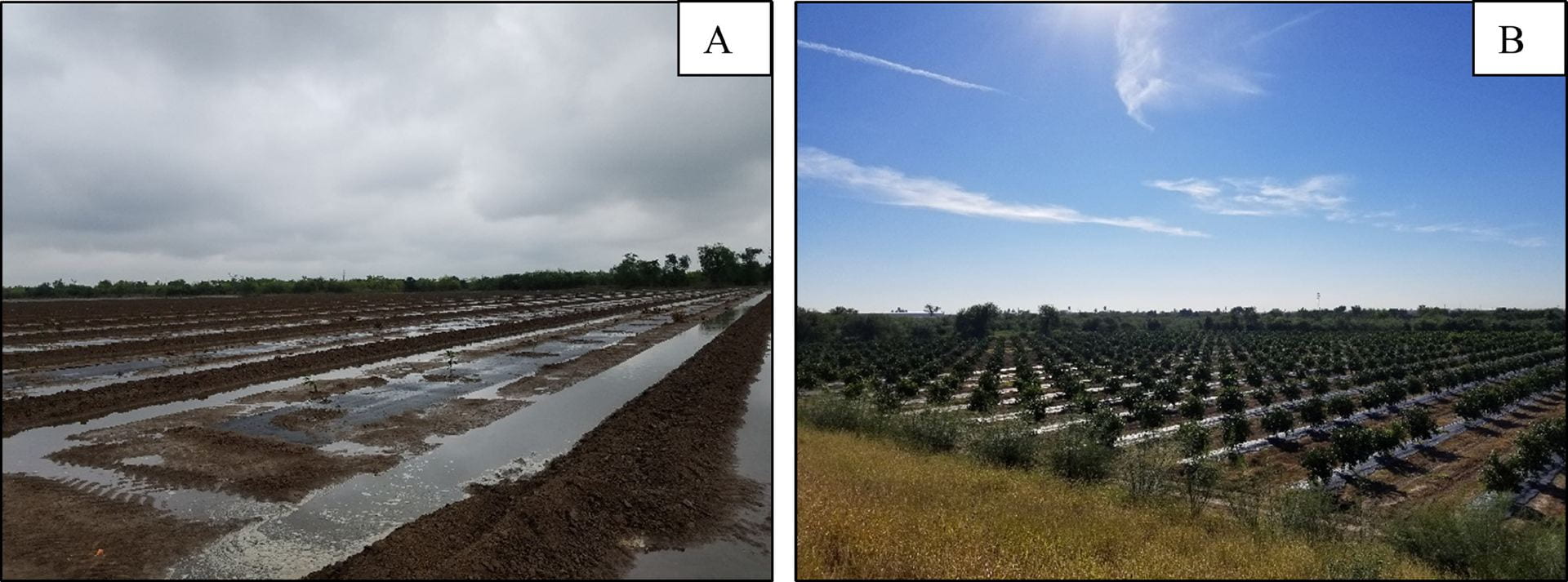With 38 public universities and 35 private colleges and universities in the state and many more across the country (and the world) interested in Texas, there’s a great deal of academic scholarship focused on water in the Lone Star State. In this column, I provide brief summaries to several recent academic publications on water in Texas.

Let’s start thinking about water!
Influence of an industrial discharge on long-term dynamics of abiotic and biotic resources in Lavaca Bay, Texas

Experimental site setup, (A) soon after planting (2016) and (B) after three years of growth (2019).
In this study funded by the Agricultural Water Conservation Grants Program at the Texas Water Development Board, Simpson and co-authors evaluated potential water savings (and water-use efficiency) for different grove-floor management strategies for citrus in the Lower Rio Grande Valley. Citrus is a perennial crop and therefore needs water all year to survive. For various reasons, about 60% to 70% of citrus farmers in the valley use flood irrigation. Grove-floor management—actively managing the ground surface of the grove—has been shown to increase growth, production, and root distribution, but no one, until this study, had investigated water use.
Over three years (from planting to first harvest), the authors studied various grove-floor management techniques (flat with no cover, flat with ground cover, raised with no cover, and raised with ground cover) at a citrus grove near Mission, Texas. The ground cover was black plastic mesh. They found that ground cover treatments resulted in a water savings of 2.2% (no discussion of the significance of this difference [which doesn’t seem like much]). They noted that weather and where they were in the establishment period appeared to have an impact on water use and that the full benefits of water savings may not be realized until the full establishment of the citrus crop.
Citation
Simpson, C., Setamou, M., and Nelson, S.D., 2023, Evaluation of citrus grove floor management strategies for water use efficiency and conservation: Scientia Horticulturae, https://doi.org/10.1016/j.scienta.2022.111680
Social disparities in the duration of power and piped water outages in Texas after Winter Storm Uri
You got an eyeful of Uri in last month’s column, and here comes another one! In this study, Grineski and crew conducted a bilingual phone survey of 753 households in eight Texas metropolitan statistical areas in July 2021 to learn more about who was affected by that dreadful winter storm and near collapse of our electric grid. For all responsive respondents, the average power outage was 42 hours. The survey showed that Black households (59 hours) were without power longer than White households (35 hours). In addition, the average water outage for Black households was longer (57 hours) than White households (32 hours). Although the study collected income information, the authors did not present an analysis of how outages related to household income levels.
Citation
Grineski, S.E., Collins, T.W., Chakraborty, J., Goodwin, E., Aun, J., and Ramos, K.D., 2023, Social disparities in the duration of power and piped water outages in Texas after Winter Storm Uri: AJPH, v. 113, no. 1, p. 30-34. https://doi.org/10.2105/AJPH.2022.307110
Hurricane Harvey delivered a massive load of mercury-rich sediment to Galveston Bay

Galveston Bay by Joseph, stock.adobe.com
Despite the National Equirerish title, this is an academic paper concerning sediment and mercury loading to Galveston Bay from Hurricane Harvey. Dellapenna and peeps collected 56 cores across Galveston Bay, including San Jacinto Estuary, Trinity Bay, Galveston Bay, East Galveston Bay, Clear Lake, and Dickinson Bayou. Based on an analysis of these cores, they estimated that Harvey deposited 131 million tons of sediment into the bay and estuary system, about 31 years’ worth of average sedimentation. Harvey also eroded 16 million tons of mercury-laden sediment from the San Jacinto Estuary and Patrick Bayou and dumped it into Galveston Bay, totaling at least 3.4 tons of mercury. The authors blame land subsidence and Addicks and Barker flood-control reservoirs for increasing the exposure time to mercury and more widely dispersing mercury in the bay.
Citation
Dellapenna, T.M., Hoelscher, C., Hill, L., Critides, L., Salgado (Bartlett), V., Bell, M., Al Mukaimi, M.E., Du, J., Park, K., and Knap, A.H., 2022, Hurricane Harvey delivered a massive load of mercury-rich sediment to Galveston Bay, TX, USA: Estuaries and Coasts https://doi.org/10.1007/s12237-021-00990-7
Join Our Mailing List
Subscribe to Texas+Water and stay updated on the spectrum of Texas water issues including science, policy, and law.

